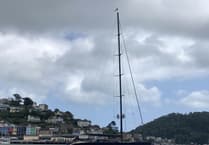PETER GREGSON, of Southford Road, Dartmouth, writes:
I wonder how many Dartmouth residents are aware of the latest proposals from Follaton House to address the parking issues in the town.
I found one notice in Mayor’s Avenue car park and reference has been made in the past two issues of the Chronicle. Alternatively, we are directed to the district council website, which is not necessarily accessible to everyone.
The basic problem is twofold: first, to satisfy the requirements of visitors; second, to meet the needs of the residents, and in particular the traders.
The assumption is that tourism is the mainstay of the town and all other considerations are of lesser importance. The reality is that, without tourism, the town would be a poorer place; but a town with no shops, no business and nowhere to park will have little attraction to a visitor.
For those who are unaware of the district council proposals, this is a summary:
* Free park-and-ride over the winter period. Sadly there will be no bus service, rendering this generous sop worthless to both residents and visitors.
* Parking on South Embankment restricted to permit holders only. There are finite places, a limited number of permits will be issued, there is no indication of the inevitable cost of a permit and no guarantee of a place even if you can afford a permit.
* No parking on North Embankment – loading only. Who loads on North Embankment?
* Parking for those with residents’ permits now proposed to be from 3pm to 10am the next day. This generous concession justifies the increase to £40 for the permit, but still does not guarantee a place.
* All other permits to be cancelled.
It is difficult to see how any of these proposals will improve the parking issues in the town.
While a few traders have their own private parking places, all others and their employees who travel to town to work have to leave their desks every hour to move their cars or risk a £30 fine, or use the park-and-ride, adding the best part of an hour to their working day – except in the winter, when the new proposals farcically suggest that they walk back up College Way in the dark to the park-and-ride.
Visitors to the town fall into two categories – long- and short-term.
Short-term visitors arrive mostly by road. Many do take advantage of the park-and-ride, but many are only passing through – they want a quick look around, a cup of coffee, perhaps buy a souvenir and get on their way. I wonder how many circle the town, fail to find a parking place and drive on.
For the benefit of the traders, these short-term visitors must be catered for to allow them to stop conveniently and spend money in the town, which is the primary purpose of tourism to any town.
Long-term visitors are either staying with friends, in hotels or in one of the many B&Bs. In the summer many do take advantage of the park-and-ride, but Mayor’s Avenue car park is always full up with long-term visitors who use their free parking permits, paid for and issued by their accommodation, blocking the spaces, or by those who can afford to feed the meter. Good income for the council, bad news for the residents and short-term visitors.
There is absolutely no need for long-term visitors to have parking permits issued by their accommodation allowing long-term parking in Mayor’s Avenue car park or anywhere else. They can and must use the park-and-ride.
Desperate situations call for desperate remedies. The only viable and currently accessible solution is to use part of Coronation Park as a car park. Forgetting for a moment the inevitable emotional outcry, considered examination of the facts is revealing.
How many people who resist the suggestion actually use the park? It appears to be principally used by dog owners with inevitable consequences. Today it is a muddy field.
Part of the park is used for cricket. This must be and can be allowed to continue. Part of the park is used for small boat storage. This is totally unnecessary. Many of these boats rarely move, the grass grows around them and the site right alongside the visitors’ arrival point on the Higher Ferry is a poor advertisement for a maritime town.
Coronation Park is a short walk on the level from the town centre – to be precise, 300 yards and four and a half-minutes’ walk to the corner of the Boat Float. As we who park our cars all know, immediate access from parking to destination is very desirable.
The spaces available in a Coronation Park car park would allow all town-centre parking to be eliminated. Just imagine the roads all round the Boat Float, the whole of Lower Street, South Embankment, Mayor’s Avenue and Smith Street all free of parked cars.
Most important of all – and the key factor in the plan – would be the conversion of the Mayor’s Avenue car park into an extension of Avenue Gardens, thus compensating for the loss of part of Coronation Park and providing a far more accessible recreational area that would better meet the needs of visitors and residents alike. A children’s recreation area could be set aside, which would undoubtedly please many parents while they shop, and a small area at the seaward end could be reserved for essential services, as at present.
There are more gardeners than dog owners in the country and they spend more money.
Obliging the use of the park-and-ride by certain categories with an all-year bus service and providing increased parking in Coronation Park would go a long way to solving Dartmouth’s infamous parking problem.
The whole of Coronation Park will accommodate more than twice the number of cars of the Mayor’s Avenue car park plus all the cars in the town centre put together.
The whole of Coronation Park less a cricket pitch will accommodate 520 cars, which equals twice the capacity of the Mayor’s Avenue car park.
The parking issue is of such major importance to the people of Dartmouth that it must not be left to Follaton House to decide, but must now be the subject of a public meeting, with Dartmouth residents able to take part in this major decision affecting the very future of the town.


